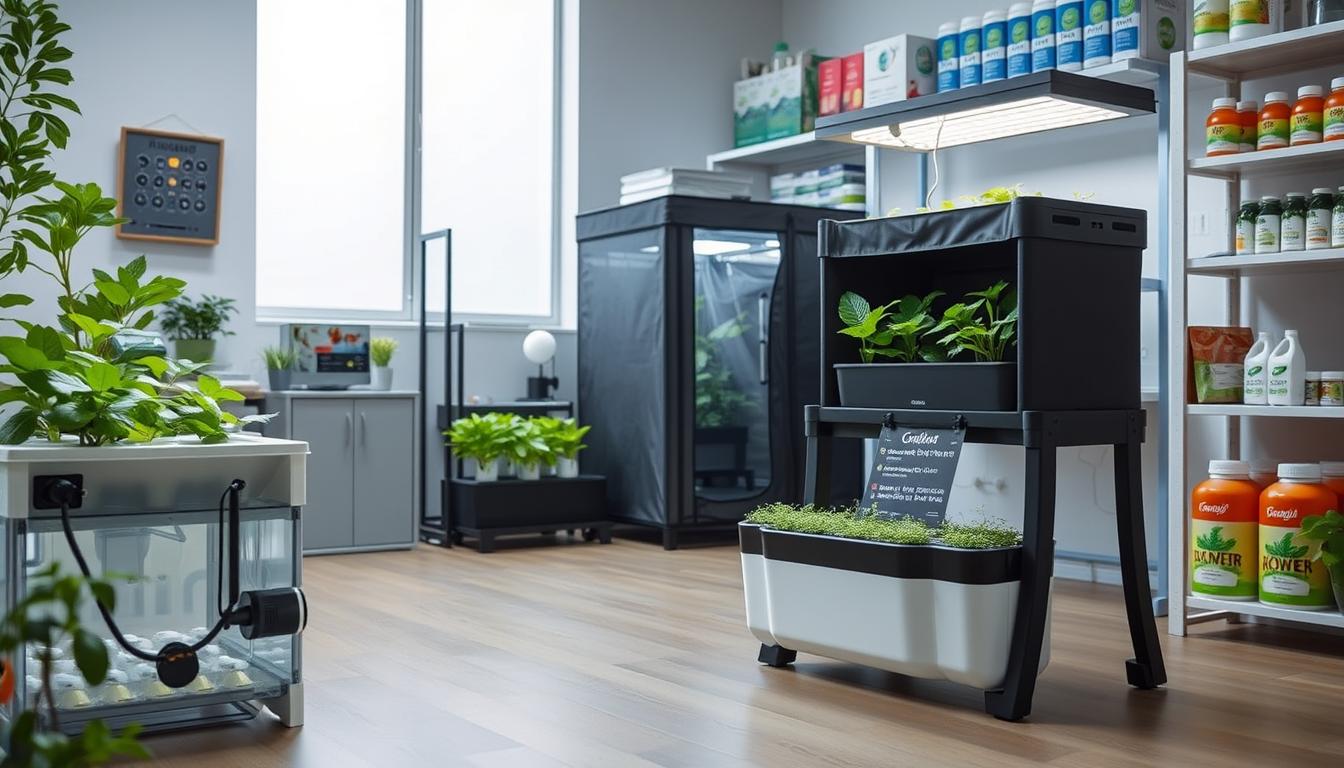Growing fresh herbs and vegetables all year without soil might seem like science fiction. But it’s becoming a reality in many American homes. Soil-free growing is a clean, efficient way to get fresh food, no matter the weather or yard space.
The demand for indoor hydroponic kits has skyrocketed in recent years. You can find everything from simple countertop units to advanced systems that almost take care of themselves. These systems can fit any space, from small windowsills to big basement gardens.
Whether you’re new to gardening or have lots of experience, hydroponic systems are exciting. They use less water than traditional gardening and grow plants faster and stronger.
In this guide, we’ll look at the best and easiest-to-use hydroponic systems. We’ll cover options for all experience levels, space sizes, and budgets. Our goal is to help you find the perfect indoor growing solution for your needs.
The Growing Popularity of Indoor Hydroponic Gardening
Indoor hydroponic gardening is becoming more popular. People enjoy growing fresh produce without using soil. This method was once only for commercial farms but is now for home gardeners too. The systems are now cheaper, smaller, and easier to use.
Our living spaces are changing, and so is gardening. More people live in cities with little outdoor space. Indoor hydroponic gardens are a great way to grow food at home. The pandemic made growing your own food even more appealing.
Now, you can find hydroponic kits for everything from herbs to big vegetable harvests. This makes hydroponic gardening accessible to everyone, not just experts.
Benefits of Growing Plants Without Soil
Soilless growing has big advantages over traditional gardening. Plants grow 30-50% faster and use up to 90% less water. This is because nutrients are delivered right to the roots, saving energy.
Pests are much less of a problem in indoor gardens. Without soil, there’s no mess, making gardening cleaner and easier. Apartment dwellers will love this.
With indoor gardens, you can control everything your plants need. This leads to healthier plants with better taste and more nutrients than regular produce.
Year-Round Harvests in Any Climate
Indoor hydroponic gardens can grow food all year, no matter the weather. In places with short growing seasons, you can have fresh produce any time. This is great for places with extreme weather.
Outdoor gardens face many challenges like frosts and pests. Indoor gardens avoid these problems, making them perfect for any climate.
| Feature | Traditional Gardening | Hydroponic Gardening | Benefit |
|---|---|---|---|
| Growing Season | Climate dependent | Year-round | Continuous harvests |
| Water Usage | High consumption | Up to 90% less water | Resource efficiency |
| Growth Rate | Standard | 30-50% faster | More frequent harvests |
| Space Requirements | Large areas needed | Compact, vertical options | Ideal for small homes |
| Maintenance | Weeding, pest control | Minimal, mostly monitoring | Less time-consuming |
Understanding How Hydroponic Systems Work
Every indoor hydroponic garden relies on a clever system. It gives nutrients directly to plant roots in ways nature never thought of. These systems might seem like new tech, but they’re based on old ideas. Today, they mix ancient wisdom with modern science to help gardeners save space and grow plants efficiently.
The Science Behind Soilless Growing
In regular gardening, soil does two main things: it supports plants and gives them nutrients. Hydroponics splits these jobs. Plants sit in materials like rockwool or coconut coir, while nutrients come from water.
At the root level, magic happens. Roots seek water and nutrients, and in hydroponics, they get exactly what they need. This setup helps plants grow faster because they don’t spend energy on finding nutrients in soil.
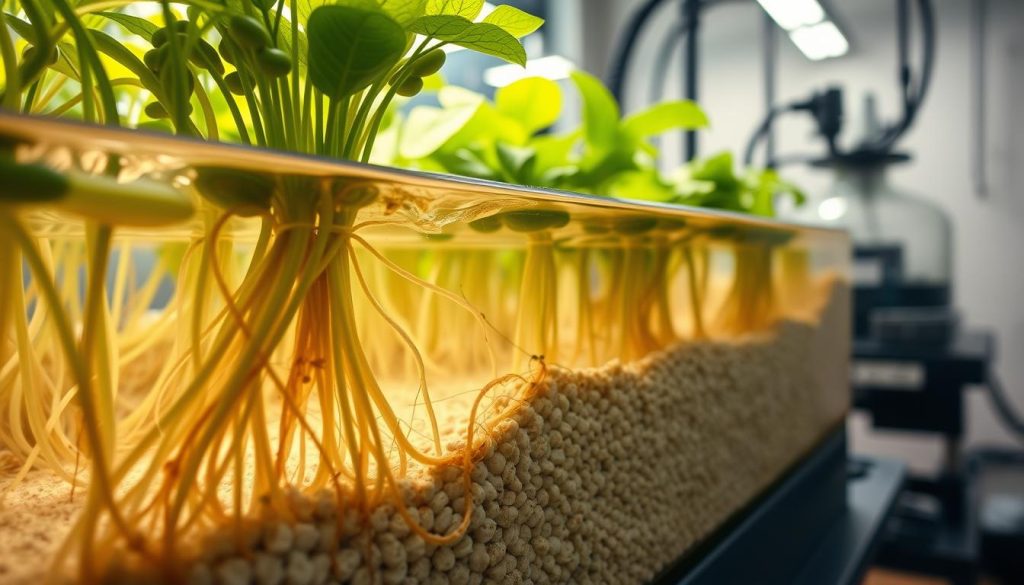
- Water enriched with balanced nutrients
- Oxygen for healthy root development
- Growing medium for support (or none in some systems)
- Light source (natural or artificial)
Hydroponic plants can grow 50% faster than those in soil. They also use up to 90% less water. This makes hydroponics great for gardeners with little space or resources.
Common Hydroponic Growing Methods
Hydroponics offers many ways to grow plants, each with its own benefits. Knowing these methods helps you pick the best one for your garden.
- Deep Water Culture (DWC): Plants float on nutrient solution with roots submerged while air pumps provide oxygen. This beginner-friendly method works well for leafy greens.
- Nutrient Film Technique (NFT): A thin stream of nutrient solution flows over roots in channels. Perfect for small plants like herbs and lettuce.
- Ebb and Flow: Growing beds temporarily flood with solution then drain. Versatile and great for various plant sizes.
- Wicking: Simple passive systems where nutrient solution “wicks” up to roots. Ideal for beginners with limited budgets.
- Drip Systems: Nutrient solution drips onto growing medium and roots. Highly customizable for different plants.
- Aeroponics: Roots hang in air and are misted with nutrient solution. Advanced but extremely efficient.
Most home hydroponic kits use one or a mix of these methods. Each has its own benefits in cost, complexity, and plant suitability. For newbies, DWC and wicking systems are the easiest to start with.
What to Look for When Choosing Indoor Hydroponic Kits
Finding the right indoor hydroponic kit is easier when you know what to look for. There are many options, from small countertop units to big systems for many plants. The best kit can make your indoor gardening great, but the wrong one can be a letdown.
Space Requirements and System Size
Before buying a hydroponic kit, measure your space well. Think about the unit’s size and how much room it needs as plants grow.
Windowsill systems need 1-2 square feet and 12-24 inches of height. Countertop units require 2-4 square feet and 2-3 feet of height. Larger systems need 4-10 square feet and up to 6 feet of ceiling space.
Some plants, like tomatoes, need more space than herbs. Pick a system that fits your plants and your space.
Ease of Use and Maintenance
The effort needed to care for hydroponic kits varies. Look for systems that fit your lifestyle and skill level.
Systems with automated nutrient dosing and pH monitoring need less daily care. Water level indicators prevent pump damage and plant stress. Easy-to-clean components make maintenance simpler.
Beginners should look for kits with pre-measured nutrients and clear guides. More experienced growers might want systems with more options, even if they need more work.
Cost and Long-term Value
The cost of hydroponic kits includes the initial price and ongoing expenses. Basic systems cost $50-$150, while advanced ones can be $300-$1,000 or more.
Think about electricity costs, which range from 10-100 watts for small systems to over 300 watts for large ones. Nutrient solutions cost $15-$30 every few months. Replacement parts like pumps and light bulbs add to the cost over time.
Calculate how much you save by growing your own food to find the break-even point. Herb-focused systems can pay off in 6-12 months with regular harvests.
| System Type | Space Required | Maintenance Level | Initial Cost | Monthly Operating Cost |
|---|---|---|---|---|
| Windowsill Units | 1-2 sq ft | Low (5 min/day) | $50-$100 | $5-$10 |
| Countertop Systems | 2-4 sq ft | Low-Medium (5-10 min/day) | $100-$300 | $10-$20 |
| Floor-Standing Units | 4-10 sq ft | Medium (10-15 min/day) | $300-$700 | $20-$40 |
| Advanced Systems | 10+ sq ft | High (15-30 min/day) | $700-$1,500+ | $40-$80 |
Best Countertop Hydroponic Gardens for Beginners
Countertop hydroponic gardens are easy to use and grow plants without soil. They fit well in kitchens or living areas. These systems are great for beginners because they’re simple and don’t require a lot of knowledge.
These gardens have features like automatic lights and reminders for water. They need little care but still produce great results. This makes them perfect for those who are new to gardening or are busy.
Let’s look at two popular options for beginners. They have helped many people grow their first hydroponic plants.
AeroGarden Harvest Elite
Overview
The AeroGarden Harvest Elite is well-known for indoor gardening. It has a sleek design and fits well on counters. The control panel is easy to use, guiding you through growing plants.
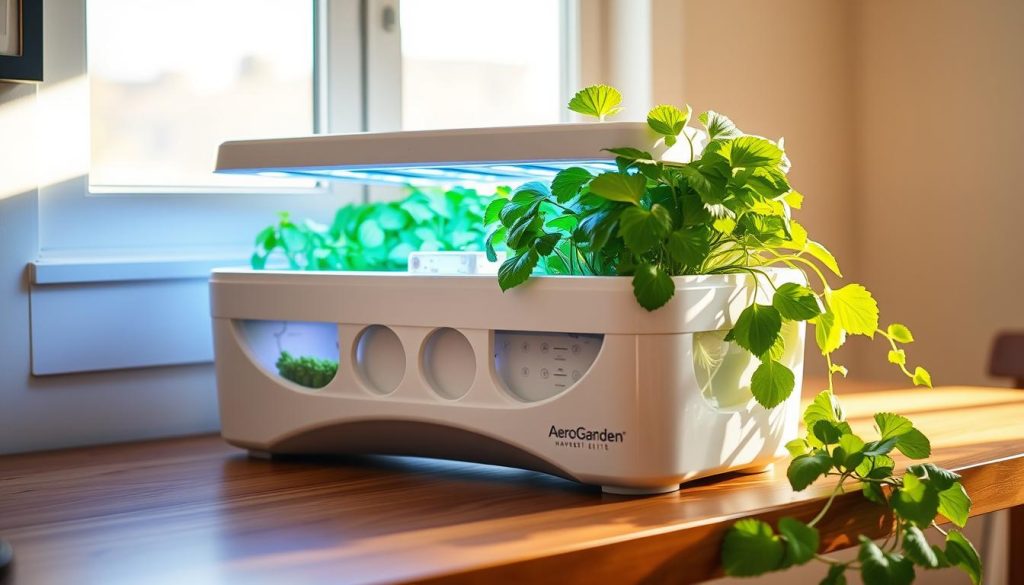
This system works automatically, so you don’t need to know much about gardening. It has strong LED lights for plant growth and is quiet, fitting any room.
But, it can only grow six plants at once. It also uses special seed pods that cost more but ensure success for beginners.
Features
The Harvest Elite has a 20W LED light system that turns on and off automatically. The control panel reminds you when to add water and nutrients. The light hood adjusts as plants grow, supporting different herbs and vegetables.
Click and Grow Smart Garden 3
Overview
The Click and Grow Smart Garden 3 is known for its simple design. It has a small profile that fits anywhere. It’s easy to use, making it great for beginners who want fresh herbs without much effort.
Pros and Cons
The Smart Garden 3 is very simple. Just add water once a month, and it takes care of the rest. It has biodegradable plant pods with special “smart soil” that controls moisture and nutrients.
But, it can only grow three plants at a time. It’s also not as customizable as other systems. While it’s perfect for herbs, it’s hard to grow bigger vegetables.
Features
Click and Grow’s LED lights are energy-efficient and provide the right spectrum for plants. The system uses smart soil that keeps the right pH levels and water release. You can also add more units as you get more confident in your gardening skills.
Top Indoor Hydroponic Kits for Herbs and Leafy Greens
Some hydroponic kits are great for growing herbs and leafy greens indoors. They have special features that help plants thrive. These kits give the right light, nutrients, and save space, making it easy to get fresh greens every day.
These systems beat traditional gardening for taste and nutrition. Freshly picked herbs and greens are always better than store-bought.
iDOO Hydroponic Growing System
Overview
The iDOO Hydroponic Growing System is a budget-friendly choice for growing herbs and greens. It has 12 pods for continuous harvests. Its design fits well on countertops, keeping herbs close while cooking.
The iDOO system has adjustable poles for taller plants. It has a pump for even nutrient distribution. It’s quiet enough for any room.
But, it’s made of plastic and needs manual nutrient adjustments. Some users add extra lights for better growth.
Features
This kit has LED lights for all-day growth. It has a water alarm and a fan that’s almost silent. The control panel lets you adjust lighting for different growth stages.
Each pod has a basket and growing medium for easy setup. It’s great for beginners.
Gardyn Home Kit 3.0
Overview
The Gardyn Home Kit 3.0 is a top-notch indoor hydroponic system. It grows up to 30 plants in just two square feet. It’s a living wall that’s both functional and beautiful.
Gardyn’s system uses AI and sensors for plant care. It’s perfect for those who are busy or new to gardening.
Pros and Cons
The Gardyn is great for small spaces. It’s automated and offers personalized advice. Its vertical design maximizes light for plants.
It’s more expensive than simpler systems. Some features require a subscription. It needs a bit more assembly than countertop models.
Features
“Kelby” is Gardyn’s AI assistant that watches over your plants. It adjusts lighting and watering based on plant needs. The system combines hydroponics with soil for better plant growth.
The Gardyn app sends notifications for plant care and harvesting. The water tank needs refilling every 2-3 weeks, making it low-maintenance.
Best Hydroponic Vegetable Kits for Year-Round Harvests
Robust hydroponic vegetable kits let home gardeners grow fresh produce all year. They’re great for growing herbs and leafy greens first. But, for bigger vegetables like tomatoes and cucumbers, they need more space and light.
These kits have evolved to meet these needs. They support larger plants and help them grow well. Let’s look at two top systems for growing vegetables all year.
Vegepod Raised Garden Bed with Cover
Overview
The Vegepod is a new way to grow plants at home. It uses self-watering tech and a cover to protect plants. It works indoors with lights or outdoors on balconies.
Its wicking system gives plants water and nutrients. The cover creates a warm spot for plants to grow longer.
Pros and Cons
The Vegepod can grow many plants at once. Its mesh cover keeps pests out but lets good bugs in. It also has a self-watering system for less work.
But, it takes up more space than vertical systems. It needs some assembly and costs more than basic kits. Yet, it’s durable and worth it.
Features
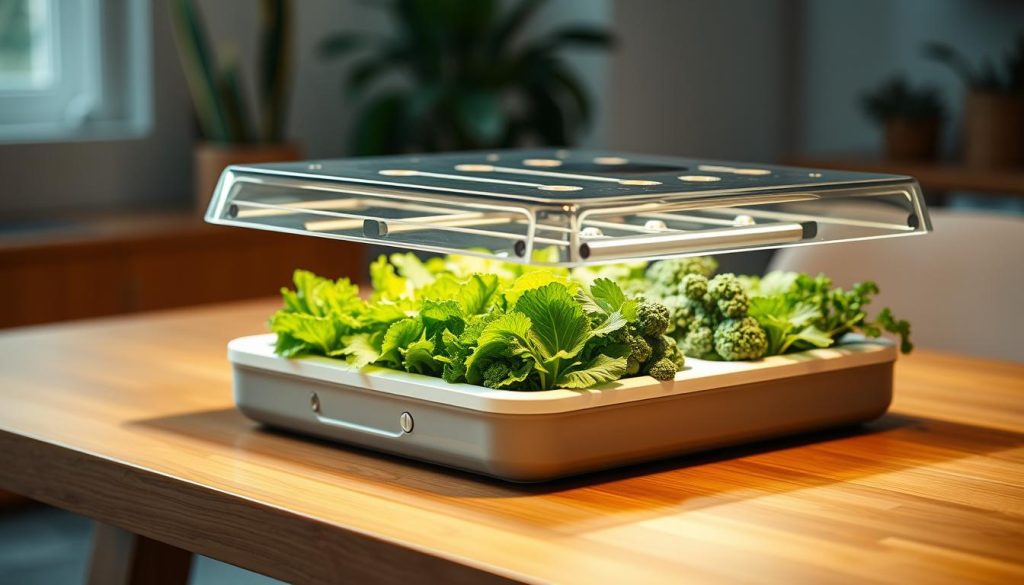
The Vegepod’s best feature is its wicking system. It keeps plants moist without drowning them. The mesh cover acts like a greenhouse but lets air in.
It has trellis options for climbing plants. The raised design makes harvesting easy. And, it’s safe for food.
Root Farm Hydroponic Garden System
Overview
The Root Farm System is made for growing big vegetables. It’s a deep water culture system that gives plants the space they need. It’s made by Miracle-Gro and has special nutrients for different plants.
Pros and Cons
Root Farm is great because you can start small and grow. It’s perfect for big vegetables with special nutrients. It grows plants fast and well.
But, it needs more space as plants get bigger. Big vegetables need strong lights, which uses more electricity. It might take more learning than simpler systems, but it’s worth it.
Features
The Root Farm system has a deep water culture design. It gives plants nutrients directly. It has special nutrients for different growth stages.
You can add more pods as your garden grows. It comes with a strong air pump for healthy roots. Both kits turn your home into a garden all year. They let you grow fresh vegetables anytime, saving money and giving you joy.
Best Vertical Hydroponic Systems for Small Spaces
Vertical hydroponic systems turn small spaces into productive gardens. They grow plants up, not out, saving space. Great for those with little room, they can grow dozens of plants in a small area.
These systems save water and space. They come with built-in lights, making them perfect for corners or walls. Let’s look at two top picks for your home.
Tower Garden HOME
Overview
The Tower Garden HOME is a marvel of design. It grows up to 32 plants in just 2.5 square feet. It’s great for small homes and apartments.
This system uses aeroponic technology for fast growth. Plants grow 30% faster and yield more. But, it’s tall and pricey.
Features
This system has everything you need for hydroponics. It includes nutrient solution, LED lights, and a wheeled base. It’s easy to move and expand as you grow.
Mr. Stacky Smart Farm
Overview
The Mr. Stacky Smart Farm is affordable and versatile. It grows 20 plants in five tiers. You can add or remove tiers to fit your space.
Pros and Cons
This system is easy to set up and customize. It’s great for small spaces. But, it needs manual watering and lacks automation.
Features
The Smart Farm has a unique design with growing pockets for light. It has a built-in reservoir for nutrients. It’s perfect for growing different plants together.
| Feature | Tower Garden HOME | Mr. Stacky Smart Farm | Best For |
|---|---|---|---|
| Growing Capacity | 32 plants | 20 plants (expandable) | Tower Garden for maximum yield |
| Floor Space Required | 2.5 sq ft | 2 sq ft | Mr. Stacky for tightest spaces |
| Growing Technology | Aeroponic | Hybrid hydroponic | Tower Garden for faster growth |
| Price Range | $$$$ (Premium) | $$ (Budget-friendly) | Mr. Stacky for cost-conscious gardeners |
| Automation Level | High (timer, lights, watering) | Low to Medium (varies by model) | Tower Garden for busy households |
Both systems show how hydroponics can thrive in small spaces. Choose the Tower Garden for tech or Mr. Stacky for flexibility. They let you grow food all year without using much space. They also add a green touch to your home.
Advanced Indoor Hydroponic Kits for Experienced Gardeners
Seasoned hydroponic enthusiasts often move to more advanced systems. These systems offer professional-grade results and more flexibility. They require a deeper understanding of plant nutrition and water chemistry.
For experienced gardeners, these systems offer customizable features. They can’t be matched by basic kits. Let’s explore two professional-grade options that represent the cutting edge of home hydroponic technology.
SuperPonics 16-Site Hydroponic System
Overview
The SuperPonics 16-Site Hydroponic System is a big step forward in home growing technology. It combines top-feed irrigation and deep water culture into one system. This hybrid approach speeds up plant growth by up to 50% compared to standard systems.
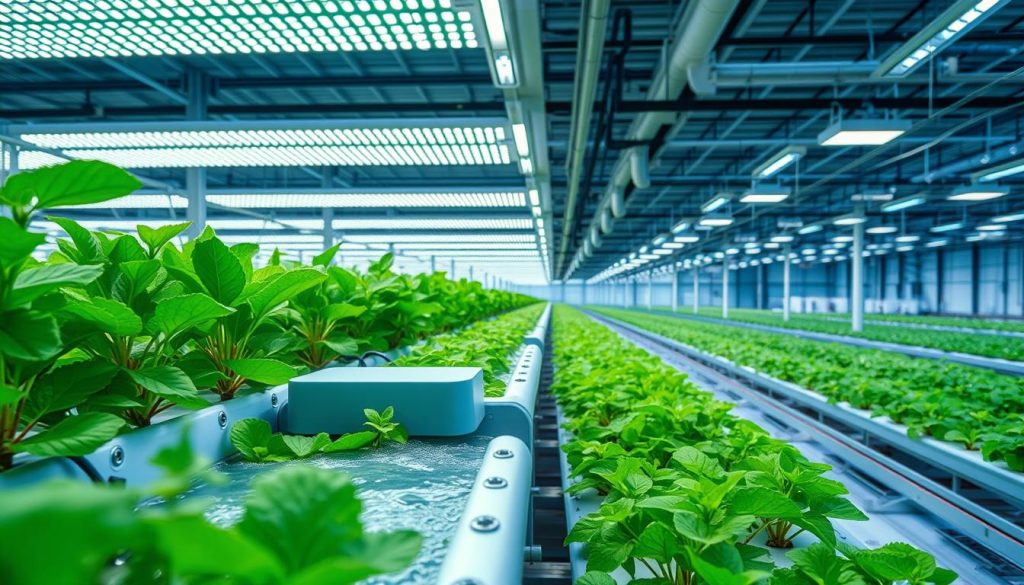
The SuperPonics’ greatest strength is its dual delivery nutrient system. It provides plants with constant oxygen-rich water and top-feeding nutrients. This creates a stable growing environment that forgives minor maintenance oversights.
The system can start with 8 plants and scale up to 16. But, new users should consider the steeper learning curve and larger space requirements. This unit needs at least 4 square feet of dedicated space and proper ventilation.
Features
SuperPonics creates an exceptionally oxygen-rich growing environment. Its patented dual delivery system is a key feature. The reservoir is eco-friendly, made from recycled, food-grade materials that ensure durability without chemical leaching.
Experienced gardeners will appreciate the customizable growing medium options. They can experiment with clay pellets, rockwool, or coco coir depending on the crop. The system includes programmable timers for precise nutrient delivery scheduling and built-in water level indicators for maintenance monitoring.
HTG Supply Bubble Brothers 6-Site DWC System
Overview
The HTG Supply Bubble Brothers 6-Site DWC System brings commercial-grade deep water culture technology into the home garden. It’s designed for larger plants with substantial nutrient demands. This system excels with fruiting crops like tomatoes, peppers, and cucumbers that benefit from its powerful oxygenation capabilities.
Unlike all-in-one beginner kits, the Bubble Brothers system focuses on perfecting the deep water culture method. This specialization delivers exceptional results for gardeners who understand the specific needs of their chosen crops.
Pros and Cons
The commercial-quality components set this system apart from consumer-grade alternatives. Its professional air pump delivers consistent oxygenation through multiple outlets, preventing root rot issues. The modular design allows for easy expansion by connecting additional buckets.
The main limitations include the need for separate lighting solutions and more hands-on management of nutrient levels and pH. This system demands regular water testing and adjustments. It’s ideal for gardeners who enjoy the scientific aspects of hydroponics rather than those seeking automation.
Features
Each of the six food-grade buckets features specialized growing baskets with optimal root zone exposure. The commercial air pump includes multiple outlets with adjustable flow rates. This allows customization for different plant varieties and growth stages.
The system includes professional-grade air stones that create micro-bubbles for maximum oxygen diffusion. Advanced growers appreciate the individual bucket design. It allows for different nutrient formulations in each container—perfect for experimenting with various crops simultaneously.
| Feature | SuperPonics 16-Site | HTG Bubble Brothers | Best For |
|---|---|---|---|
| Growing Method | Hybrid (Top-feed + DWC) | Deep Water Culture only | SuperPonics for versatility |
| Plant Capacity | 8-16 plants | 6 larger plants | SuperPonics for quantity |
| Maintenance Level | Moderate (3-4 times weekly) | High (daily monitoring) | SuperPonics for convenience |
| Price Range | $350-450 | $200-300 | HTG for budget-conscious |
| Expandability | Limited to 16 sites | Unlimited with additional buckets | HTG for long-term growth |
Both these advanced hydroponic growing kits require a greater commitment of time and knowledge than beginner systems. They reward experienced gardeners with significantly higher yields and precise control over growing conditions. They also offer the satisfaction of mastering professional-level hydroponic techniques.
The investment in these sophisticated systems pays dividends through year-round harvests of exceptional quality produce. For those who have outgrown simpler setups, these advanced options open new possibilities in indoor gardening productivity.
Budget-Friendly Self-Watering Planters and Hydroponic Systems
For gardeners on a budget, today’s market has great hydroponic options. These systems are affordable and still offer top-notch growing results. They’re perfect for beginners or those wanting to grow more without spending a lot.
DreamJoy Hydroponic Grow Kit
Overview
The DreamJoy Hydroponic Grow Kit uses NFT technology in a space-saving design. It has multiple growing sites in horizontal layers. This lets you grow many plants at once without using much space. It’s a great choice for starting with hydroponics.
This system is great value for money and can grow more as your garden gets bigger. It saves water and cuts down on costs. But, it’s made of plastic, which might not last as long as more expensive options. You also have to add nutrients by hand, not automatically.
Features
This kit comes with a water pump and timer, so you can set watering times for your plants. It includes everything you need to start growing, like baskets and sponges. The system recirculates water, saving water and being kind to the environment.
VIVOSUN Hydroponic Grow Kit
Overview
The VIVOSUN Hydroponic Grow Kit is perfect for beginners and is easy on the wallet. It has everything you need to start growing right away. Its design is simple, making it easy for new gardeners to use while still getting great results.
Pros and Cons
VIVOSUN’s biggest plus is that it comes with everything you need to start. Their customer support is also very helpful. But, it has a simpler design with fewer automated features than more expensive models. Some users find they need to upgrade the water pump later.
Features
The system has durable tubes that prevent algae and an efficient pump for nutrient flow. It comes with starter nutrients, making it easy for beginners. It’s also easy to clean and maintain, which is key for success with hydroponics. The kit includes instructions and tips for growing herbs and leafy greens.
| Feature | DreamJoy Hydroponic Kit | VIVOSUN Hydroponic Kit | Best For |
|---|---|---|---|
| Price Range | $75-95 | $65-85 | Budget-conscious beginners |
| Growing Sites | 36 sites (expandable) | 8-12 sites | DreamJoy for larger harvests |
| Growing Method | NFT (Nutrient Film Technique) | DWC (Deep Water Culture) | Depends on plant preferences |
| Included Nutrients | No (purchased separately) | Yes (starter pack included) | VIVOSUN for immediate start |
| Automation Level | Basic timer controls | Manual operation | DreamJoy for convenience |
Smart Hydroponic Plant Growers with App Control
Smart gardeners are loving new smart hydroponic systems. These systems can be controlled through smartphone apps. They mix tech and nature, making growing plants easy and fun.
These gardens connect to your Wi-Fi. So, you can check on your plants from anywhere. They send alerts about water, nutrients, and when to harvest.
Rise Gardens Personal Garden
Overview
The Rise Gardens Personal Garden is a Wi-Fi-connected hydroponic system. It’s modern and has a sleek design. It fits up to 12 plants and looks great in any home.
It was made by engineers and plant scientists. They brought commercial tech to your home.
Pros and Cons
The Rise Gardens system has a great app and automatic nutrient dosing. The app gives care tips for each plant. But, it’s pricey and has a subscription model for extra features.
This garden has customizable LED lights that mimic sunlight. It checks water quality and alerts you when needed. The app sends care tips and tracks your plants’ growth.
You can also expand it as you grow.
Lettuce Grow Farmstand
Overview
The Lettuce Grow Farmstand is a stylish, self-watering vertical garden. It’s made from recycled plastic and uses 95% less water than traditional gardens. It can grow 12 to 36 plants, depending on how you set it up.
Pros and Cons
The Farmstand is both a garden and a piece of home décor. It has pre-sprouted seedlings and grows a lot in small spaces. But, its app is simpler than some, and some plants do better outdoors.
Features
The Farmstand has a timer for watering and nutrients. It’s easy to start small and add more. It also has optional LED lights for indoor growing.
The app reminds you to maintain and harvest your plants.
| Feature | Rise Gardens Personal Garden | Lettuce Grow Farmstand | Best For |
|---|---|---|---|
| Plant Capacity | Up to 12 plants | 12-36 plants (expandable) | Farmstand for larger harvests |
| App Capabilities | Comprehensive monitoring, nutrient tracking, growth data | Basic maintenance reminders, harvest schedules | Rise Gardens for tech enthusiasts |
| Design Style | Modern, horizontal countertop unit | Vertical tower, statement piece | Farmstand for space efficiency |
| Price Range | $299-$549 | $348-$649 (depending on size) | Rise Gardens for entry-level |
| Lighting | Built-in adjustable LEDs | Optional Glow Rings (sold separately) | Rise Gardens for indoor growing |
DIY Home Hydroponics: Building Your Own System
You can make your own hydroponic growing system with basic materials and tools. It’s cheaper than buying one and teaches you how it works. Growing your own food adds a special feeling to your gardening.
Essential Components for a DIY Setup
To start your home hydroponics, you need the right parts. You can find these at local stores or online for less than commercial systems.
- Containers: Use food-grade buckets, plastic totes, or recycled bottles as reservoirs. Choose opaque ones to stop algae.
- Growing medium: Net pots and clay pellets or rockwool cubes support plants and let roots get nutrients.
- Water circulation: An air pump with air stones (about $15-20) is needed for DWC systems. Kratky setups don’t need a pump.
- Nutrient solution: Pre-mixed hydroponic nutrients cost $10-20 and last for many cycles.
- Lighting: LED grow lights are efficient, starting at $30 for small setups.
Step-by-Step Assembly Guide
Building a basic DWC system is easy and great for beginners. It keeps roots in nutrient-rich, oxygenated water.
- Drill holes in the lid of your container for net pots (2-3 inches diameter).
- Install the air pump outside and connect it to air stones inside the reservoir.
- Fill the container with water and add nutrients as instructed.
- Check and adjust pH to 5.5-6.5 with a pH test kit.
- Put net pots in the holes and add growing medium.
- Place plants or seeds in the medium, making sure roots touch the water.
- Position your grow light 6-12 inches above plants, adjusting as they grow.
The Kratky method is simpler, needing no electricity or pumps. Just fill your container so water touches the bottom of net pots. As plants grow, their roots follow the water level, and the top stays in air.
Transforming Your Home with Indoor Hydroponic Gardening
Indoor hydroponic gardens do more than provide food. They create a living space within your home. These green spaces clean the air and make any room look better.
Homeowners get creative with their hydroponic gardens. They put units on kitchen counters for easy access to herbs. Living walls become eye-catching features in living rooms. Even small spaces can use vertical systems to save room.
Hydroponic gardening is great for families. Kids learn about plants and where food comes from. Watching plants grow and picking fresh food is a special experience.
It’s also good for the planet. Growing your own food cuts down on packaging and transportation. Hydroponics use up to 95% less water than traditional gardening.
Begin with a small unit for lettuce or herbs. As you get better, add bigger systems for more food. The joy of eating what you grew is unmatched.
Indoor hydroponic gardens are a smart step toward self-sufficiency. They work in any climate and space. By using this technology, you improve your health and home.

